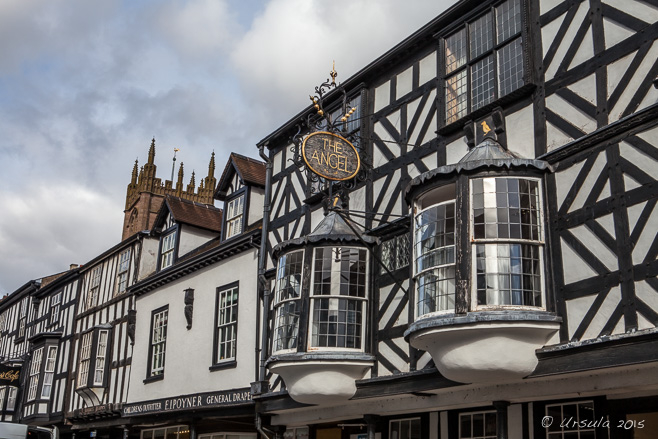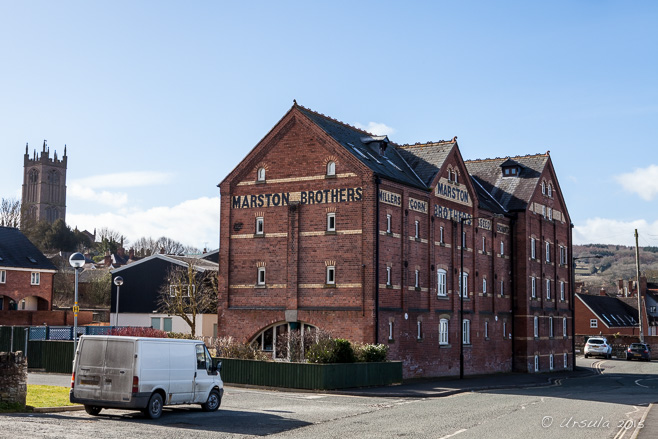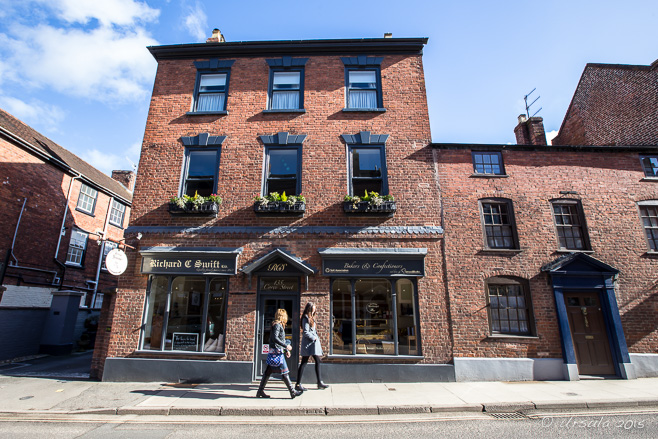
The Angel Inn – Broad St, Ludlow
Originally built in the 1500s with a top story added as late as the 1700s, The Angel operated as an inn from as early as 1555.
The term “black and white village” refers to several old English villages in the counties of Herefordshire and Shropshire in the West Midlands of England.
These villages are known for their timbered and half-timbered houses, some dating to medieval times. The framework of the houses was made from unseasoned green oak, which darkened over time; painting the beams black was a relatively recent innovation. The panels between the beams were covered with plaster – or sometimes with brick – and painted with lime wash.
Ludlow, a thriving medieval market town in the Shropshire Hills with top class restaurants and around 500 heritage listed buildings, is a particularly finest example of a “black and white village”.

Every Town has a Grain Store
Walking into the town centre from the train station is like walking into the past… Apparently, this old warehouse has been converted into flats. Who would know?

Walking Street
Are these “brownstones”? As in: buildings made of brown Triassic-Jurassic sandstone bricks? I don’t know – but there is a real sense of stately permanence on Corve Street, Ludlow, as one walks past the Richard C Swift Ltd – “Quality family bakers since 1863” – shopfront.

The Famous Feathers
The Feathers Hotel is one of about 500 heritage-listed buildings in Ludlow – and one of its best known and most-photographed. Built in 1619 by local lawyer Rees Jones, it is a Tudor-style half-timbered building.

Inside the Feathers
Probably the finest old timber-fronted black-and-white house in Ludlow, the Feathers Inn is known for its beautiful Tudor architecture and elegant Jacobean refurbishment.

The Barista
The young man who had made and delivered my coffee saw that I was taking an interest in the marvellous old building. He offered to take me upstairs for a look at some of the other rooms.

Ornate Plaster Ceilings
The story my young guide told me was that some years ago, this ceiling collapsed because an upstairs guest had let a bathtub overflow. The artisan commissioned with the repairs was a nationally-recognised elder-relative of my young man – who was justifiably proud of his ancestor.

Fading Tapestry
The corridors and stairwells are richly decorated with old paintings, furniture, and tapestries – this one dated from 1318.

Lead Windows
Cast diamond glazing keeps old glass looking new – and the oak frames have also withstood time.

The Feathers
This amazing building, with its three bay widows, has been called the “most handsome inn in the world”.

Stationary Shop
Plenty of charming shops in keeping with the town’s medieval facade line the streets.

A Bicycle and a Post Box
How quintessentially British! A stone wall, a bicycle, and a pillar box.

The Bull Hotel
The 15th century medieval coach-inn, the Bull Hotel on the Bull Ring, predates the Feathers Inn across the road by some years.

King Street
Historic buildings can be spotted along every curving roadway. The Buttercross, with its clock tower, sits at the top of King Street.

The Buttercross
It is a beautiful, sunny, winter day as I head into the Buttercross (built 1743-46): the official centre of town.

College Street

St Laurence’s Church
With Norman foundations dating back to the 11th century, St Laurence’s Parish Church in the centre of town was rebuilt in 1199 – with major expansions between 1433 and 1471. It is considered one of England’s outstanding medieval town churches.

Stained Glass Windows – St Laurence’s Parish Church

Chaplain Barry and the Misericords
One of the church chaplains tells visitors to the church about the small folding seats, or ‘misericords’, designed to provide some comfort to people standing for long periods of prayer in the medieval choir stall.

Cautionary Tales
The fold-down seats (mercy seats) are richly carved with cautionary tales: this one depicts a dishonest ale-wife being carried to hell by demons.

In the Bell Tower
Ludlow is famous for its church bells, which are housed in an imposing 41-metre (135 feet) high tower immortalised by the poet A E Housman in “A Shropshire Lad”.

Atop the Bell Tower
The 550-year-old tower is weathered …

View over Ludlow
… but affords magnificent 360° views over the town and countryside.

Graveyard behind the Church

The Buildings of Broad Street
Running a short distance from the Buttercross to the town-wall gatehouse, Broad Street is one of the finest stretches of “black and white” houses in England, with some excellent examples of medieval and Tudor-style half-timbered buildings.

Quality Square
Ludlow is known for it’s food, and corners of town are given over to fine restaurants and boutique shops.

Another Bicycle – Harp Lane
The coffee shops and markets are also a delight.

Ludlow Castle
Ludlow Castle was founded around 1075 and was one of the first stone castles to be built in England. It is credited to Walter de Lacy (d. 1085), a Norman nobleman who was given extensive lands in Herefordshire and Shropshire by King William I of England.

Sir Mortimer and Lady Grey
Roger Mortimer acquired the castle in 1301 and the family held it for over a century. Today, the castle is owned by John Herbert, current Earl of Powis, and is managed as a private tourist attraction.

Ludlow Castle Canon
“English Heritage” lists Ludlow as “one of England’s finest castle sites”.

Dinham Road
Ludlow was known as “Dinham” in its early years, and the road just south of the castle still bears this name.
Ludlow is a delightful place to visit: not the least because I had a superb lunch and bought some fine china at market prices.

It just goes to show: you can preserve your heritage and still attract visitors to a modern, thriving, market town.
Wishing you Happy Travels!
Pictures: 27February2015


































.jpg)


Ursula,
Very nice “overview”!!
Loved the Barista, the Chaplin and Sir Mortimer and Lady Grey are winners.
Ruti
Thanks, Ruti – really nice to have your ‘visit’. 😀
[…] that houses the Black Lion Pub. The Midlands is “Black and White” country (see: Medieval Ludlow), and a few of these distinctive buildings survive in Hereford […]
The photographs are wonderful: crisp images and nicely composed.
I have stayed in Ludlow and so it is good to see the sights again.
Thanks so much for your visit and comment, Sally! I’d love to get back there. 🙂